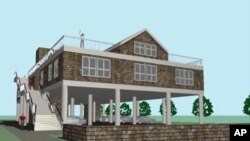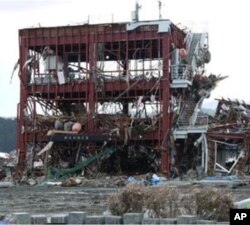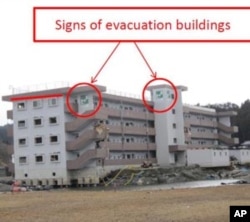The horrible, gripping images of destruction from the Japanese earthquake and tsunami are still on the minds of everyone living in the string of beach towns that dot the rugged Pacific coastlines of Oregon and Washington State.
In Westport, Washington, "high ground" is three long lines of low beach dunes. If the worst came to pass, most people would want to be a little bit higher.
Refuge towers
"You look at some of those pictures and you could just picture Westport or Grayland, the same thing. It would just sweep right across the peninsulas," says retiree Linda Orgel, one of hundreds of coastal residents spurred to become better prepared.
That interest is being channeled into planning and design meetings for a possible series of man-made refuge towers.
Westport apartment manager Harold Gray assumes when the big one hits, the roads leading inland or to the hills will be impassable. "We live down toward the docks. You wouldn’t have the time to get to high ground. It just wouldn’t happen. This gives us another option, which is what we need because high ground is far away."
A four-year federal grant to Washington State’s Emergency Management Division is paying for conceptual design work on so-called "vertical evacuation structures." Examples could include a tower that doubles as a bird-viewing or whale-watching platform. Another possibility is to build a tall earthen berm along a sports field that could also have bleachers on it.
Multiple-use structures
The University of Washington is helping to facilitate community brainstorming in low- lying towns along the Pacific coast. The structures need to have multiple uses.
"These towers really can’t be single purpose to have any lasting effect," says Bob Freitag, the university’s hazard mitigation expert. "They would be ignored. They’ll be an eyesore. They have to be part of the community."
In Southwest Washington’s Pacific County, meeting-goers decided they wanted 13 berms, five towers and two parking garages spaced along the coastline to give people the means to shelter from a tsunami.
The only place in the world that’s actually done this sort of thing is Japan. The March 11 tsunami provided the first real-world test of tsunami evacuation structures.
Real-world test
Coincidentally, University of Washington tsunami researcher Jody Bourgeois was in northern Japan at the time.
Bourgeois says fleeing up a reinforced concrete building seems to have provided safe refuge from the rushing, rising water - most of the time. "In some cases the building was not as high as the tsunami, which was larger than the design was."
According to Bourgeois, the tsunami overtopped a three-story office building in the town of Minamisanriku. The structure had been designated as a safe haven, but around 20 people were swept away.
"I would say if you’re going to build a vertical evacuation structure, the major cost would be in the structure itself," she says. "Adding another floor is not the major cost. So I guess after this event I would say, add another floor. Make it higher."
None of the Pacific Northwest beach towns thinking about this has the money to build a tsunami-safe haven. But first things first, says Washington Emergency Management’s John Schelling. "In my experience, it is really difficult to obtain any kind of resources or funding without having a plan. That is really what this project is designed to do."
Seaside, Oregon is another vulnerable place. Town officials are discussing whether the roof of an expanded convention center could double as a tsunami refuge.
In Cannon Beach, Oregon, some residents are pressing to elevate a new city hall on sturdy concrete stilts. As for the people of Japan, a more detailed survey of what worked and what didn’t during the recent disaster awaits an "all clear" from emergency responders. They haven’t yet finished recovering bodies from the sea of rubble the tsunami left behind.













